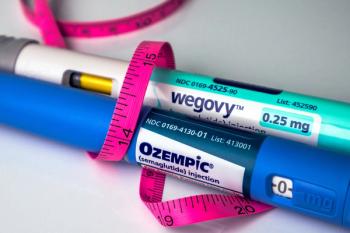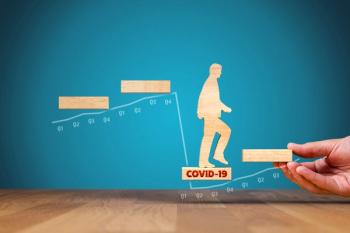
- Drug Topics July/August 2024
- Volume 168
- Issue 06
Pfizer Advances Oral GLP-1 Development as the Race for Second-Gen Obesity Therapies Continues
Pfizer joins Eli Lilly and Novo Nordisk in the development of oral GLP-1 receptor agonist candidates.
Pfizer will advance their development of danuglipron, a once-daily oral glucagon-like peptide 1 (GLP-1) receptor agonist, the company announced in a news release.1
The decision is based on results of an ongoing pharmacokinetic study (
Across Pfizer’s pipeline of clinical and pre-clinical candidates for obesity, danuglipron is the most advanced, according to Mikael Dolsten, MD, PhD, chief scientific officer and president of Pfizer Research and Development. “We believe a once-daily formulation has the potential to have a competitive profile in the oral GLP-1 space.”
The company plans to initiate dose optimization studies in the second half of this year, “evaluating multiple doses of the preferred modified release formulation” to inform registration studies.
Oral
The Second Generation of Obesity Therapies
Pfizer joins Eli Lilly and Novo Nordisk—manufacturers of
Eli Lilly has 2 obesity-focused therapies in their phase 3 pipeline: orforglipron, a once-daily oral nonpeptide GLP-1 receptor agonist, and retatrutide, a gastric inhibitory polypeptide/GLP-1/glucagon receptor triagonist.3
Phase 2 study results for both drugs are promising. Positive data from a phase 2, randomized, double-blind clinical trial (
READ MORE:
Data from a phase 2 study of retatrutide (
Orforglipron is also being evaluated for use in type 2 diabetes (
In 2023, Eli Lilly acquired Versanis, a deal that included the company’s weight loss drug bimagrumab.8 Bimagrumab, a monoclonal antibody that binds the activin/myostatin type II receptors ActRIIA and ActRIIB and blocks ligand binding, is being evaluated in a phase 2 clinical trial. The company’s phase 2 pipeline also includes mazdutide, a mammalian oxyntomodulin analogue that acts like a GLP-1 receptor/glucagon receptor dual agonist, and higher doses of GIP/GLP-1 receptor agonist tirzepatide.
Novo Nordisk has a similarly active obesity pipeline.9 In addition to a phase 3 study of semaglutide 7.2 mg, the company is conducting phase 3 studies of CagariSema, a subcutaneous, once-weekly combination of amylin analogue cagrilintide and GLP-1 analogue semaglutide, and a long-acting, once-daily oral semaglutide.
A successful phase 2 study of CagriSema (
READ MORE:
Results from a 68-week phase 3a efficacy and safety trial, OASIS 1 (
Novo Nordisk’s phase 2 obesity pipeline includes monlunabant, an oral small molecule CB1 receptor blocker,9 and a novel, noninvasive ultrasound treatment for type 2 diabetes and obesity being developed in conjunction with GE HealthCare.14
Supply and Demand
As patient demand for obesity medication soars, shortages have—perhaps predictably—become common. Both tirzepatide and semaglutide remain in shortage, according to the
Simultaneously, health care systems are “tightly restricting reimbursement of anti-obesity therapies,” wrote IQVIA vice president Markus Gores.16 These systems are “struggling with how to reconcile the need to tackle obesity as a major, growing public health crisis, how to fund a new mass market, chronic disease area potentially valued at up to $131 billion globally by 2028, while ensuring equity of access,” Gores explained.
Relief may be on the horizon, however distant: in addition to the treatments being evaluated by Pfizer, Eli Lilly, and Novo Nordisk, more than 120 weight loss therapies, with multiple mechanisms of action and different formulations, are in development across 60 companies, including Boehringer Ingelheim (survodutide, a subcutaneous GIP/GLP glucagon receptor agonist) and Takeda (cetilistat, an oral gastric and pancreatic lipase inhibitor).17 Although promising, Gores noted that the first new competitors to currently approved injectable semaglutide and tirzepatide likely will not enter the market until 2027.
While research and development teams continue their investigations into obesity therapies, a new understanding of obesity as a condition has begun to emerge. “There is a growing understanding among health care stakeholders that a one-dimensional view of obesity solely defined by BMI is grossly inadequate to capture the complexity of its various manifestations,” Gores wrote. This recognition can expand the definition of treatment success, and allow for more personalized, patient-centric outcomes, including durable weight maintenance, cardio-metabolic-renal comorbidity management, muscle mass preservation, tolerability, and convenience.
As obesity rates continue to rise—in conjunction with increases in comorbidities such as type 2 diabetes, heart disease, and cancer—the development and commercialization of therapies for overweight and obesity are crucially important. Addressing challenges, including payer funding and equitable access, and finding solutions will, Gores believes, create a therapeutic market that “will look very different” from the market of today: More segmented, more defined by patient needs, and more competitors seeking differentiation.
READ MORE:
References
Pfizer advances development of once-daily formulation of oral GLP-1 receptor agonist danuglipron. News release. Pfizer. July 11, 2024. Accessed July 12, 2024.
https://www.pfizer.com/news/press-release/press-release-detail/pfizer-advances-development-once-daily-formulation-oral-glp FDA approves first oral GLP-1 treatment for type 2 diabetes. News release. FDA. September 20, 2019. Accessed July 12, 2024.
https://www.fda.gov/news-events/press-announcements/fda-approves-first-oral-glp-1-treatment-type-2-diabetes Medicines in development. Eli Lilly. Updated April 30, 2024. Accessed July 12, 2024.
https://www.lilly.com/discovery/clinical-development-pipeline Lilly’s phase 2 results published in the New England Joural of Medicine show orforglipron, a once-daily oral nonpeptide GLP-1 receptor agonist, achieved up to 14.7% mean weight reduction at 36 weeks in adults with obesity or overweight. News release. Eli Lilly. June 23, 2023. Accessed July 11, 2024.
https://lilly.mediaroom.com/2023-06-23-Lillys-phase-2-results-published-in-the-New-England-Journal-of-Medicine-show-orforglipron,-a-once-daily-oral-nonpeptide-GLP-1-receptor-agonist,-achieved-up-to-14-7-mean-weight-reduction-at-36-weeks-in-adults-with-obesity-or-overweight Wharton S, Blevins T, Connery L, et al, for the GZGI Investigators.Daily oral GLP-1 receptor agonist orforglipron for adults with obesity. N Engl J Med. 2023;389;877-888. doi:10.1056/NEJMoa2302392
Lilly’s phase 2 retatrutide results published in the New England Journal of Medicine show the investigational molecule achieved up to 17.5% mean weight reduction at 24 weeks in adults with obesity and overweight. News release. Eli Lilly. June 26, 2023. Accessed July 12, 2024.
https://lilly.mediaroom.com/2023-06-26-Lillys-phase-2-retatrutide-results-published-in-The-New-England-Journal-of-Medicine-show-the-investigational-molecule-achieved-up-to-17-5-mean-weight-reduction-at-24-weeks-in-adults-with-obesity-and-overweight Jastreboff AM, Kaplan LM, Frías JP, et al, for the Retatrutide Phase 2 Obesity Trial Investigators. Triple–hormone-receptor agonist retatrutide for obesity—a phase 2 trial. N Engl J Med. 2023;389:514-526. doi:10.1056/NEJMoa2301972
Waldron J. Hungry for more, Lilly tops off weight loss pipeline with $1.9B deal to acquire Versanis. Fierce Biotech. July 14, 2023. Accessed July 12, 2024.
https://www.fiercebiotech.com/biotech/eli-lilly-fills-out-weight-loss-pipeline-19b-deal-acquire-versanis R&D pipeline. Novo Nordisk. Accessed July 12, 2024.
https://www.novonordisk.com/science-and-technology/r-d-pipeline.html Novo Nordisk successfully completes phase 2 trial with CagriSema in people with type 2 diabetes. News release. Novo Nordisk. August 22, 2022. Accessed July 12, 2024.
https://www.novonordisk.com/content/nncorp/global/en/news-and-media/news-and-ir-materials/news-details.html?id=131155 Novo Nordisk launches trial of pipeline drug CagriSema versus newly approved Zepbound. Clinical Trials Arena. November 17, 2023. Accessed July 12, 2024.
https://www.clinicaltrialsarena.com/analyst-comment/novo-nordisk-cagrisema-versus-zepbound/?cf-view Novo Nordisk A/S: Oral semaglutide 50 mg achieved 15.1% weight loss (17.4% if all people adhered to treatment) in adults with obesity or overweight in the OASIS 1 trial. News release. Novo Nordisk. May 2, 2023. Accessed July 12, 2024.
https://www.novonordisk.com/news-and-media/news-and-ir-materials/news-details.html?id=166110 Knop FK, ArodaVR, do Vale RD, et al, for the OASIS 1 Investigators. Oral semaglutide 50 mg taken once per day in adults with overweight or obesity (OASIS 1): a randomised, double-blind, placebo-controlled, phase 3 trial. Lancet. 2023;402:10403(705-719). doi:10.1016/S0140-6736(23)01185-6
GE HealthCare and Novo Nordisk to collaborate to advance novel non-invasive treatment for type 2 diabetes and obesity with ultrasound. News release. GE HealthCare. October 19, 2023. Accessed July 12, 2024.
https://www.gehealthcare.com/about/newsroom/press-releases/ge-healthcare-and-novo-nordisk-to-collaborate-to-advance-novel-non-invasive-treatment-for-type-2-diabetes-and-obesity-with-ultrasound?npclid=botnpclid Gil B. A pill could solve the Zepbound and Wegovy shortage, Eli Lilly executive says. Quartz. Updated May 15, 2024. Accessed July 12, 2024.
https://qz.com/weight-loss-drug-shortage-eli-lilly-zepbound-ozempic-1851477159 Gores M. When the dust settles: The future shape of the obesity market. IQVIA. May 13, 2024. Accessed July 12, 2024.
https://www.iqvia.com/blogs/2024/05/when-the-dust-settles Armstrong A. The obesity pipeline was ‘late breaking.’ Here’s what the R&D landscape looks like now. Fierce Biotech. March 19, 2024. Accessed July 12, 2024.
https://www.fiercebiotech.com/biotech/late-breaking-obesity-glp-1-wegovy-zepbound-novo-lilly-pipeline-rd-landscape
Articles in this issue
over 1 year ago
Get Into Politics or Get Out of Pharmacyover 1 year ago
The 2024-2025 Flu Season: What to Expectover 1 year ago
CDC, ACIP Announce Vaccine Recommendations and Updatesover 1 year ago
Examining the Role of Remote CGM in Diabetes ManagementNewsletter
Pharmacy practice is always changing. Stay ahead of the curve with the Drug Topics newsletter and get the latest drug information, industry trends, and patient care tips.




